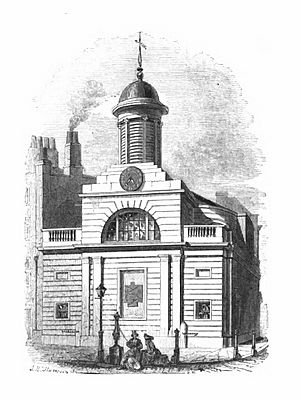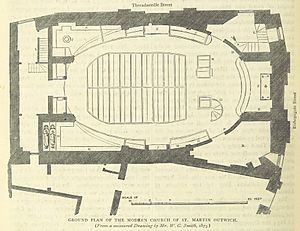St Martin Outwich facts for kids
Quick facts for kids St Martin Outwich |
|
|---|---|

The church in the early 19th century
|
|
| Denomination | Church of England |
| Architecture | |
| Demolished | 1874 |
| Administration | |
| Diocese | Diocese of London |
St Martin Outwich was an old church in the heart of London. It stood at the corner of Threadneedle Street and Bishopsgate. This church was first built a long time ago, in the Middle Ages. It was rebuilt in the late 1700s and then taken down in 1874.
How the Church Started
The First Church Building
A church named St Martin was built in the 1300s. It was paid for by members of the Oteswich family. This is where the church got the second part of its name, "Outwich."
Surviving Fires and Decay
The church was lucky and did not burn down in the Great Fire of London in 1666. However, over time, the building started to fall apart. In 1765, a fire badly damaged it. This fire also destroyed 50 other houses nearby. The original church had a main hall (nave) and a side area (south aisle). It also had a tower at the west end.
Who Owned the Church?
The right to choose the church's priest, called the patronage, first belonged to the Earls of Surrey. Later, the Outeswich family took over this right. Eventually, it was given to the Merchant Taylors' Company. This was a powerful group of merchants in London.
Building a New Church
Why a New Building Was Needed
By 1796, the old church was in very bad shape. An act of Parliament was passed to let the local area raise money. This money would be used to rebuild the church.
Who Helped Pay?
Many groups helped pay for the new church. The Worshipful Company of Merchant Taylors gave £500. The City of London Corporation and the South Sea Company each gave £200. The total cost to rebuild the church was £5,256.
Construction and Opening
The first stone for the new church was laid on May 4, 1796. The famous architect Samuel Pepys Cockerell designed the building. The new church was officially opened in November 1798. A new organ was added in 1805 by George Pike England.
Inside the New Church
Cockerell's design for the church was quite unique. The main part of the church was oval-shaped. At the east end, there was a special area for the altar, called the chancel. The walls inside had decorative columns (pilasters). From the top of these columns, the ceiling curved upwards. This ceiling had four half-circle windows. A fifth window, located above the altar, had beautiful stained glass. This glass showed coats-of-arms from the old medieval church.
Many old memorials from the first church were also kept. These included one for John Outeswich and his wife. There was also a large painting above the altar. It showed the Ascension of Jesus. This painting was done by John Francis Rigaud. Sadly, it started to look bad within ten years.
Changes Over Time
When the church was first built, the pulpit (where the priest spoke) was at the west end. The church benches (pews) faced away from the altar. In 1827, Charles Barry made some repairs and changes. As part of this work, the pulpit was moved to a different spot.
The Church's Look from Outside
The front of the church, facing Bishopsgate, looked very strong and rough. This style is called "rusticated." One writer, James Peller Malcolm, said it looked like "a complete representation of a gaol." A "gaol" is an old word for a prison. He thought it looked too strong and not very pretty for a small church. The side of the church facing Threadneedle Street was very plain.
The Church's End
When and Why It Was Taken Down
The church of St Martin Outwich was taken down in 1874. Its local area (parish) was then joined with the nearby church of St Helen's Bishopsgate.
What Happened to Its Parts?
Before St Martin's was destroyed, eighteen of its memorials were moved to St Helen's. The church bell was given to St. Andrew's Church, Fulham.
The Old Churchyard
In 1540, a churchyard was given to St Martin Outwich. This churchyard was on Camomile Street. Today, it is still there as a small garden. You can find it in the courtyard of an office building.
Funding a New Church
The money made from selling the land where St Martin Outwich stood was used for something new. It helped pay for the building of Holy Trinity Church, Dalston. This new church was designed by Ewan Christian and built between 1878 and 1879.
Images for kids



